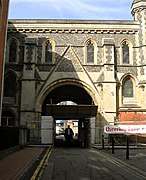Reading Abbey Inner Gateway
The gateway marked the division between the area of the abbey open to the public and the section accessible only to monks, with the abbot's lodging just inside the gateway. The gateway thus became the meeting place between the abbot, who commanded considerable powers within the town, and the people of the town. In 1539, after the dissolution, Hugh Faringdon, the last abbot of Reading was hanged, drawn, and quartered outside the abbey gateway. Whilst the other buildings of the abbey were stripped for lead and stone, the abbot's lodging was turned into a royal palace on the orders of Edward Seymour, who was acting as lord protector as King Edward VI was still a child. The abbey gateway was also retained, as the entrance to the royal residence.
Edward's sister, Queen Elizabeth I, was a regular visitor to the royal palace, but during the Civil War the old abbot’s lodgings were damaged, and were not used as a royal palace again. Eventually the palace was demolished and new houses were built alongside the gateway. In the late 18th century one of them was home to the Reading Ladies’ Boarding School, attended amongst others by the novelist Jane Austen. The school used the room above the gateway as a classroom.
The gateway was heavily restored by Sir George Gilbert Scott, after a partial collapse during a storm in 1861. In 1900 a series of twelve heads, sculpted by Andrew Ohlson, were added to the gateway.
In 2010, the gateway was closed and fencing erected when some of the decorative stonework came loose and fell into the street. It reopened in 2018 after an extensive restoration, which was supported by the Heritage Lottery Fund. The room above the gateway is now used by Reading Museum as part of its learning programme for local schools, whilst the arch below is available for use by pedestrian and cycle traffic. The Reading Half Marathon, held every year in March or April, passes under the gateway at around the 7 miles (11 km) stage.
Gallery
-
The northern side of the gateway depicted in 1808
-
The northern side in c.1893 after Scott's restoration
-
The southern side before Scott's restoration
-
The southern side in 2010 with protective fencing
References
- ^ "The Inner Gateway". The Friends of Reading Abbey. Archived from the original on 25 August 2011. Retrieved 7 June 2011.
- ^ "Abbey Gate, Reading". British Listed Buildings. Archived from the original on 18 January 2012. Retrieved 7 June 2011.
- ^ "State of the Environment Report – Chapter 2 – The built environment and landscape" (PDF). Reading Borough Council. Archived from the original (PDF) on 21 May 2006. Retrieved 23 April 2010.
- ^ "Abbey Gateway". readingabbeyquarter.org.uk. Reading Borough Council. Archived from the original on 31 January 2020. Retrieved 31 January 2020.
- ^ Ford, David Nash. "The Abbey Gateway". Royal Berkshire History. Nash Ford Publishing. Archived from the original on 7 February 2010. Retrieved 2 May 2009.
- ^ Hylton, Stuart (1 April 2008). Reading, past and present. Sutton Publishing Ltd. p. 23. ISBN 0750949007.
- ^ "Abbey Gateway Heads" (PDF). Potts VC Memorial Site. Potts VC Trust. Archived (PDF) from the original on 10 February 2020. Retrieved 10 February 2020.
- ^ "Reading's Abbey Gateway shut over safety fears". BBC News. 15 February 2010. Archived from the original on 31 January 2020. Retrieved 7 June 2011.
- ^ Fort, Linda (15 February 2010). "Falling stone closes Abbey Gateway". Reading Post. Archived from the original on 22 February 2010. Retrieved 7 June 2011.
- ^ Slevin, Jennie (6 January 2015). "Reading Half Marathon 2015: How the course changeos for this year's run". www.getreading.co.uk. Trinity Mirror Southern. Archived from the original on 2 April 2015. Retrieved 14 January 2015.
External links
 Media related to Abbey Gateway, Reading at Wikimedia Commons
Media related to Abbey Gateway, Reading at Wikimedia Commons



